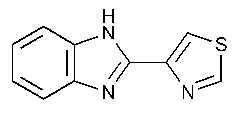Thiabendazole
»Thiabendazole contains not less than 98.0percent and not more than 101.0percent of C10H7N3S,calculated on the dried basis.
NOTE—Thiabendazole labeled solely for veterinary use is exempt from the requirements of the tests for Residue on ignition,Selenium,Heavy metals,and Chromatographic purity.
Packaging and storage—
Preserve in well-closed containers.
Identification—
A:
Infrared Absorption á197Kñ—Do not dry specimens.
C:
Dissolve about 5mg in 5mLof 0.1Nhydrochloric acid,add 3mg of p-phenylenediamine dihydrochloride,and shake to dissolve.Add about 0.1g of zinc dust,mix,and allow to stand for 2minutes.Add 5mLof a solution prepared by dissolving 20g of ferric ammonium sulfate in 75mLof water,adding 10mLof 1Nsulfuric acid,and diluting with water to 100mL:a blue or blue-violet color develops.
D:
The RFvalue of the principal spot in the chromatogram of the Identification test preparationcorresponds to that of Standard preparation A,as obtained in the test for Chromatographic purity.
Loss on drying á731ñ
—Dry it in vacuum at 100 for 2hours:it loses not more than 0.5%of its weight.
for 2hours:it loses not more than 0.5%of its weight.
Residue on ignition á281ñ:
not more than 0.1%.
Selenium á291ñ:
0.003%,a 200-mg test specimen being used.
Heavy metals,Method IIá231ñ:
0.001%.
Chromatographic purity—
Standard preparations—
Dissolve USP Thiabendazole RSin glacial acetic acid,and mix to obtain a solution having a known concentration of 1.0mg per mL.Dilute quantitatively with glacial acetic acid to obtain Standard preparations A,B,and Chaving the following compositions:
| Standard preparation |
Dilution | Concentration (µg RS per mL) |
Percentage (%,for comparison with test specimen) |
| A | (1in 4) | 250 | 0.5 |
| B | (3in 20) | 150 | 0.3 |
| C | (1in 20) | 50 | 0.1 |
Test preparation—
Dissolve an accurately weighed quantity of Thiabendazole in glacial acetic acid to obtain a solution containing 50mg per mL.
Identification preparation—
Dilute a portion of the Test preparationquantitatively with glacial acetic acid to obtain a solution containing 0.25mg per mL.
Procedure—
Apply separately 10µLof the Test preparation,10µLof the Identification preparation,and 10µLof each Standard preparationto a suitable thin-layer chromatographic plate (see Chromatography á621ñ)coated with a 0.25-mm layer of chromatographic silica gel mixture.Position the plate in a chromatographic chamber,and develop the chromatograms in a solvent system consisting of a mixture of toluene,glacial acetic acid,acetone,and water (60:20:8:2)until the solvent front has moved about three-fourths of the length of the plate.Remove the plate from the developing chamber,mark the solvent front,and allow the solvent to evaporate.Examine the plate under short-wavelength UVlight,and compare the intensities of any secondary spots observed in the chromatogram of the Test preparationwith those of the principal spots in the chromatograms of the Standard preparations.No secondary spot from the chromatogram of the Test preparationis larger or more intense than the principal spot obtained from Standard preparation (0.5%),and the sum of the intensities of all secondary spots obtained from the Test preparationcorresponds to not more than 1.0%.
Assay—
Dissolve about 160mg of Thiabendazole,accurately weighed,in 10mLof glacial acetic acid.Add 50mLof acetic anhydride,1mLof mercuric acetate TS,and 2drops of crystal violet TS,and titrate with 0.1Nperchloric acid VS(the color change at the endpoint is from blue to blue-green).Perform a blank determination,and make any necessary correction.Each mLof 0.1Nperchloric acid is equivalent to 20.13mg of C10H7N3S.
Auxiliary Information—
Staff Liaison:Behnam Davani,Ph.D.,MBA,Senior Scientist
Expert Committee:(PA7)Pharmaceutical Analysis 7
USP28–NF23Page 1904
Pharmacopeial Forum:Volume No.29(1)Page 126
Phone Number:1-301-816-8394
